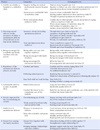Abstract
Purpose
This study was to understand the meaning of women's experience of spontaneous delivery with midwives at midwifery clinics or home.
Methods
van Kaam's Psychophenomenological method composed of a four-stage, 12-step format was used. In-depth interviews were carried out from January to July, 2011, with twelve women.
Results
Through the data analysis, 403 significant statements, 172 elements, 48 subcategories, and 19 categories were extracted, and from the 19 categories, 8 themes were drawn. The eight themes were: "Conflict on whether a hospital or a midwifery clinic", "Choosing natural delivery with the assurance of her ability to delivery spontaneously and having trust in the midwives." "Being encouraged by a midwife and family members with one accord", "Experience of the spontaneous delivery process on body", "Comfortable delivery in spite of painful process", "Deeply impressed by the overwhelming joy of birth", "Satisfaction with spontaneous delivery", and "Deeper love among family members".
Conclusion
Through this study, women's delivery experiences with midwives was of spontaneous delivery. Women's birth of self-confidence and trust between the midwives and the women to predict a spontaneous delivery is a powerful factor. Also, family support and midwives delicate care was identified as factors in spontaneous delivery.
Summary Statement
▪ What is already known about this topic?
Women's delivery at midwifery clinic is more comfortable than hospital delivery.
▪ What this paper adds?
Women's delivery experience with midwives was of spontaneous delivery. Women on the birth of self-confidence and trust between midwives and women to predict a spontaneous delivery is powerful factor.
▪ Implications for practice, education and/or policy
For spontaneous delivery, it is important that trust be built between the midwives and the women.
References
1. Callister LC. Making meaning: Women's birth narratives. J Obstet Gynecol Neonatal Nurs. 2004; 33(4):508–518.

2. Lindgren H, Erlandsson K. Women's experiences of empowerment in a planned home birth: A Swedish population-based study. Birth. 2010; 37(4):309–317.

3. Eom JM. Effect of labor induction on cesarean delivery rates in term pregnancies [master's thesis]. Ulsan: University of Ulsan;2011.
4. Kringeland T, Daltveit AK, Møller A. How does preference for natural childbirth relate to the actual mode of delivery? a population-based cohort study from Norway. Birth. 2010; 37(1):21–27.

5. How your baby birth? [television broadcast]. SBS spacial. Seoul: SBS: Public Broadcasting Service;2012 Jun 24. Available from: http://vod.sbs.co.kr/player/vod_player.jsp\?filename=cu0214i0029700.
6. Janssen PA, Henderson AD, Vedam S. The experience of planned home birth: Views of the first 500 women. Birth. 2009; 36(4):297–304.

7. Hutton EK, Reitsma AH, Kaufman K. Outcomes associated with planned home and planned hospital births in low-risk women attended by midwives in Ontario, Canada, 2003-2006: a retrospective cohort study. Birth. 2009; 36(3):180–189.

8. O'Brien B, Chalmers B, Fell D, Heaman M, Darling EK, Herbert P. The experience of pregnancy and birth with midwives: Results from the Canadian maternity experiences survey. Birth. 2011; 38(3):207–215.
9. Janssen PA, Ryan EM, Etches DJ, Klein MC, Reime B. Outcomes of planned hospital birth attended by midwives compared with physicians in British Columbia. Birth. 2007; 34(2):140–147.

10. Essex HN, Pickett KE. Mothers without companionship during childbirth: An analysis within the Millennium Cohort Study. Birth. 2008; 35(4):266–276.

11. Kang MJ. A study on the childbirth experience at maternity clinic. J Cheju Halla Coll. 1995; 19(1):7–20.
12. Lee KS. Experience of the women who succeeded natural birth after cesarean section [dissertation]. Daejeon: Chungnam National University;2003.
13. Kim JH. Experience of self-directed birth: The birth of new self [dissertation]. Seoul: Yonsei University;2003.
14. van Kaam A. Formative spirituality volume four-scientific formation. New York: Crossroad;1987. p. 99–115.
15. De Koninck M, Blais R, Joubert P, Gagnon C. Comparing women's assessment of midwifery and medical care in Quebec, Canada. J Midwifery Womens Health. 2001; 46(2):60–67.
16. Lawrence A, Lewis L, Hofmeyr GJ, Dowswell T, Styles C. Maternal positions and mobility during first stage labour. Cochrane Database Syst Rev. 2009; (2):CD003934.

17. Harper B.
MR Song
. Gentle birth choices. Rochester: Healing Art Press;1994.
18. Reveiz L, Gaitán HG, Cuervo LG. Enemas during labour. Cochrane Database Syst Rev. 2013; (7):CD000330.

19. Vahratian A, Zhang J, Troendle JF, Sciscione AC, Hoffman MK. Labor progression and risk of cesarean delivery in electively induced nulliparas. Obstet Gynecol. 2005; 105(4):698–704.

20. Hatem M, Sandall J, Devane D, Soltani H, Gates S. Midwife-led versus other models of care for childbearing women. Cochrane Database Syst Rev. 2008; (4):CD004667.

21. Janssen PA, Saxell L, Page LA, Klein MC, Liston RM, Lee SK. Outcomes of planned home birth with registered midwife versus planned hospital birth with midwife or physician. CMAJ. 2009; 181(6-7):377–383.

22. Rosen P. Supporting women in labor: Analysis of different types of caregivers. J Midwifery Womens Health. 2004; 49(1):24–31.

23. Jang MJ, Park KS. Effect of family-participated delivery in a labor delivery room on the childbirth of primiparas. Korean J Women Health Nurs. 2002; 8(3):371–379.

24. Walker R, Turnbull D, Wilkinson C. Strategies to address global cesarean rates: A review of the evidence. Birth. 2002; 29(1):28–39.
25. Kim JS. The effect of mother-fetus interaction promotion program of talking and tactual stimulation on mother-fetus interaction and mother-infant play interaction. Korean Parent Child Health J. 2002; 5(2):253–276.
26. Kim JH. The patient to the doctor, mother to the midwives. J Korean Midwives. 2001; 11(1):15–19.
27. Hildingsson I, Rådestad I, Lindgren H. Birth preferences that deviate from the norm in Sweden: Planned home birth versus planned cesarean section. Birth. 2010; 37(4):288–295.

28. Odent M.
EJ Jang
. Birth reborn. London: Souvenir Press;1994.
29. Hodnett ED. Pain and women's satisfaction with the experience of childbirth: A systematic review. Am J Obstet Gynecol. 2002; 186(5):S160–S172.

30. Jang YA. The characteristics and utilization status of method for birth giving and the problems connected with childbirth [master's thesis]. Seoul: Seoul National University;2004.




 PDF
PDF ePub
ePub Citation
Citation Print
Print




 XML Download
XML Download